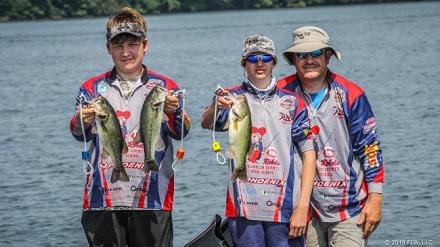
Sports Destination Management: Bass fishing is really growing! We’ve seen its growth at the collegiate level, and it’s good to see that it’s starting even younger than that. How long as the High School Fishing Circuit been around?
Joseph Opager: The FLW/TBF (The Bass Federation) High School Fishing circuit was launched in 2011 to promote education, the love of nature and outdoors through fishing. It offers students at more than 23,000 high schools across the United States and Canada the opportunity to compete in club, state, conference and national bass tournaments for the chance to earn college scholarships.

Opager: In our partnership with the TBF, each event is a little different. The TBF organizes runs 42 “State Championship” tournaments, which feature high school anglers from that specific state competing for the title of State Champion. In these events, top anglers advance to the prestigious High School Fishing National Championship tournament. These events are standalone events.
SDM: How many tournaments do you run?
Opager: FLW organizes and runs 24 “Open” tournaments. These events are held in conjunction with our College Fishing Circuit – the College events compete on Friday, the High School events on Saturday. The Open tournaments are open to high school fishing teams across the country – there is no specific state requirements. Top finishers in these tournaments also advance to the prestigious High School Fishing National Championship tournament.
 SDM: How many events are in the circuit, and do they culminate in a national championship?
SDM: How many events are in the circuit, and do they culminate in a national championship?
Opager: There are 66 total events (42 State Championships, 24 Open Tournaments). The top 10 percent of each Challenge, Open, and state championship field will advance to the 2020 High School Fishing National Championship on the Mississippi River in La Crosse, Wisconsin. The High School Fishing national champions will each receive a $5,000 college scholarship to the school of their choice.
SDM: What is the season for high school bass fishing? (Obviously, the season will coordinate with the school year, but are there any certain months for tournament – or does that fluctuate, depending on the region?)
Opager: It varies by region – typically starts early spring in the south and runs through late fall.
SDM: Is the number of schools with teams increasing, holding steady, dipping, etc.?
 Opager: The number of schools and participants are definitely steadily increasing!
Opager: The number of schools and participants are definitely steadily increasing!
SDM: What does the High School Fishing Circuit offer, prize-wise?
Opager: Anglers fish for trophies, medals, scholarship money and prizes for themselves AND their schools.
SDM: What rules govern high school students when they are fishing – such as having an adult in the boat, PFDs, etc.?
Opager: Full rules can be found here on our site.
SDM: What do students need to have/bring in order to take part in a tournament?
Opager: Each club is different and has their own unique rules/qualifications.
SDM: Are there any areas in the country that have a stronger bass fishing club/team presence? Are there teams from states you wouldn’t have expected?
 Opager: States in the south tend to have more members and opportunities, but there are high school fishing clubs across the country.
Opager: States in the south tend to have more members and opportunities, but there are high school fishing clubs across the country.
SDM: What are the demographics – more men than women? An even split?
Opager: There are more males than females, but there is definitely a female presence in the sport. It’s a rough estimate, but I’d guess 85 percent male, 15 percent female.
SDM: How does the organization select locations for its events (what factors go into consideration, apart from being an area that has a good bass population, obviously)?
Opager: Three main factors – the fishery, the facilities, and the local support. It has to be a fishery that can handle the fishing pressure and not suffer – we want to leave these lakes as good as when we arrive. Second, we need a facility that can get dozens or hundreds of boats in and out of the water efficiently and safely. We need plenty of parking, and a location where we can host our weigh-ins, which are streamed to the world at FLWFishing.com. And we look for local support – is the community happy that we are there? Will there be fans and spectators? Etc.
 SDM: Who should interest locations contact if they want to submit a bid for an event?
SDM: Who should interest locations contact if they want to submit a bid for an event?
Opager: They can contact FLW’s Chris Hoover, National Site Sales Director, at chris.hoover@flwfishing.com
SDM: Does FLW see interest at the college level as well? Do you see former student anglers showing up as adults on the regular FLW circuit?
Opager: Absolutely. We’ve seen anglers come up through the system and quite a few FLW Tour professionals started out in the High School and College Fishing ranks.
SDM: What else can you tell us about high school fishing?
Opager: Similar to any other after school club, high school fishing anglers hold regular meetings, elect officers and have coaches or parent advisers. The program is designed to get students in schools across the country excited about fishing. FLW/TBF High School Fishing also adds purpose to their education by giving them real-life examples how education items like math, science, and language arts are used by anglers out on the water every day. Schools or students can visit HighSchoolFishing.org for more details or to find out how to start a club at school.

 HighSchoolFishing.org
HighSchoolFishing.org